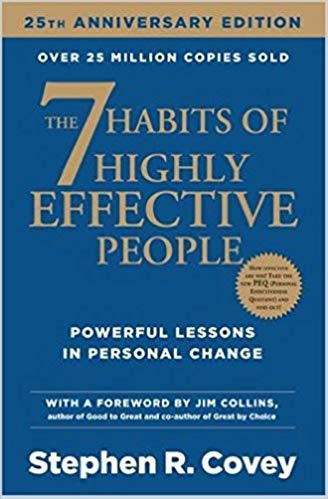

This article is an excerpt from the Shortform summary of "The 7 Habits of Highly Effective People" by Stephen Covey. Shortform has the world's best summaries of books you should be reading.
Like this article? Sign up for a free trial here .
What are your personal paradigms? How do you see the world at a high level?
At the root of your beliefs and behaviors are a collection of personal paradigms, which are influenced by your family, education, work, religion, friends, and culture. A personal paradigm is essentially the lens through which you see the world. If you don’t create your own self-paradigm, you’re left to piece together a self-image that’s based on the opinions and feedback you get from others.
Read more to learn about the concept of a personal paradigm and how your paradigms affect your behavior.
What Is a Personal Paradigm?
We all have many paradigms that influence how we interpret the world. There are two types of paradigms: Paradigms that help us interpret the way things should be shape our values, while paradigms that help us interpret the way things are shape our realities.
Each person’s experiences create different paradigms, so two people with different paradigms can look at the same facts, interpret them completely differently, and both be right. So when you think about how to change your behavior based on changing paradigms, you also need to think about different paradigms other than your own.
For example, there is a well-known optical illusion titled “My Wife and My Mother-in-Law.” It is a drawing that can be viewed as the face of a young woman looking away or as the profile of an old woman’s face. Say you first see the young woman, and then someone points out the older woman; if you avert your eyes and then look back, you are likely to still see the young woman first because your initial impression conditioned how you see the drawing. “My Wife and My Mother-in-Law” shows how hard it is to change the way to see something, how to change your character, or shift your paradigm.
Personal paradigms also work this way: A lifetime of conditioning frames your perceptions and behaviors, and only with persistent, deliberate effort can you shift your paradigms. But first, you have to recognize that you have these paradigms and understand how they’re affecting your behavior.
We are so accustomed to our paradigms that we seldom even realize we have them, let alone question their accuracy. If you spent your whole life with nearsighted vision and never put on glasses to correct it, would you realize anything was wrong?
Rather than question our own views, when other people’s paradigms cause them to interpret something differently than we do, we typically assume they’re wrong. When you become aware of your paradigms, you can begin to examine and question them, and acknowledge that other people’s beliefs and behaviors are shaped by their own paradigms. Evaluating your paradigms helps you become more open-minded to others’ perceptions, and ultimately expand your own view of the world.
Despite how your personal paradigms cause you to interpret the world, there are indisputable principles that are part of reality—including fairness, integrity, honesty, human dignity, potential, growth, and patience.
Paradigms Dictate How You See the World
In order to develop your character and act in alignment with principles such as honesty and integrity, you must first examine your paradigms, which are the lenses through which you see the world. Your paradigms shape how you interpret your situations and surroundings, and your interpretations dictate your behavior. Thus, changing your paradigm changes your behavior.
Consider this example of how paradigms, interpretations, behaviors, and results are intertwined:
Paradigm #1: A supervisor believes that people act primarily for their own gain.
Interpretation #1: She notices that her subordinates seldom take the initiative to start tasks, and she assumes (per her paradigm) that this is because employees slack off given the opportunity.
Behavior #1: She micromanages her team in order to keep everyone on task.
Result #1: Her micromanaging actually causes the people on her team to hesitate to initiate tasks, because she interferes so much that they don’t feel that they have the freedom to act independently.
Now, imagine the supervisor in this scenario had a different paradigm.
Paradigm #2: The supervisor shifts her paradigm to believe that people are intrinsically motivated to do a good job.
Interpretation #2: When she sees her team members taking an unexpected approach to a task, she assumes they’re being innovative—not slacking off—because her paradigm dictates that they are invested in the team’s collective success.
Behavior #2: She gives employees freedom to work independently and checks in periodically to provide support.
Result #2: Her subordinates are empowered to tackle each project with their best effort, even if they approach things differently than their supervisor would. Additionally, this freedom shows the workers that their supervisor has confidence in them, which motivates them to work hard and perform.
Covey explains that everyone has a patchwork of paradigms that are influenced by a lifetime of exposure to the world—family, education, work, religion, friends, and culture. Ironically, although our paradigms determine all of our thoughts, actions, and emotions, we are so accustomed to them—like a fish to water—that we seldom even realize that they exist, let alone question their accuracy. For example, your political beliefs are a paradigm through which you view events and people. Think of the last time that you responded emotionally to a president’s speech (whether positive or negative); how much did you pause to question why you felt that way, and what paradigms colored your interpretation of that speech?
Becoming aware of the paradigms you have is the first step to changing your behavior. The thoughts and behaviors you want to improve are merely the outgrowths of your paradigms, and you can’t truly get rid of a weed unless you dig up its root. It won’t be easy—a lifetime of conditioning frames your perceptions and behaviors, and only with persistent, deliberate effort can you shift your paradigms.
| Identifying a Problem Is the First Step to Fixing It Covey is not the only self-help author to recognize that, in the process of self-improvement, awareness of the problem is often half the battle. Awareness is so fundamental to making changes that admission of the problem is the first step in the Twelve-Step program for Alcoholics Anonymous, as described in The Big Book. Life coach and self-help guru Tony Robbins presents the same quandary in his first book, Awaken the Giant Within, as he explains that we typically adopt values (such as freedom or success) and beliefs (for instance, you can do anything you put your mind to) without consciously realizing it. If those values and beliefs are at the root of disempowering behaviors, our ignorance can sabotage our Herculean efforts at self-improvement. For instance, valuing success may cause you to become a workaholic at the expense of your relationships. Try as you might to find happiness and balance through self-help programs, you may not realize that the voice in your head that’s pushing you to succeed in your self-improvement is also sabotaging your effort by urging you to put in overtime at the office instead of spending quality time with your family. |
How to Change Your Paradigms
Identifying your paradigms is the first step to changing them—but what do you do next?
Prescription #1: Change Your Thoughts
In the early self-help classic As A Man Thinketh, author James Allenalso emphasizes the importance of addressing the cause of your problems, rather than trying to fix the symptoms. And at the root of your problems, he argues, are your thoughts: When you think negatively, your words and actions are negative, and that elicits negative reactions from others, creating a vicious cycle. By contrast, when you think positive thoughts, you radiate and receive positivity in a virtuous cycle.
In order to take control of your thoughts, Allen suggests reflecting on your past experiences and then tracing them back to the seedling thoughts that created those realities. This exercise helps you see how your thoughts shape your life, which motivates you to think more positively. With that motivation, make an effort to notice your thoughts and try to keep them positive. Over time, positive thinking will become a habit.
Prescription #2: Reprogram Your Neuro-Associations
Nearly a century after Allen published his advice, Tony Robbins took this concept to a more cellular level. In Awaken the Giant Within, Robbins argues that at the root of all your actions and decisions are neuro-associations that link certain experiences with pain and others with pleasure. For example, if you have a happy memory of listening to a particular song, you subconsciously associate that song with pleasure; if you were unhappy—even if for a reason unrelated to the song—you connect that song with pain. Using these neuro-associations as a guide, your brain directs you to make choices that replicate pleasurable associations and avoid painful ones.
To change these neuro-associations, and thus alter your behavior, Robbins describes a six-step reprogramming process called Neuro-Associative Conditioning:
1) Identify the result you want as well as the reason you haven’t yet achieved it. For example, you want to be more open-minded to other political paradigms, but you have negative associations about people on the other side of the aisle.
2) Vividly envision the consequences of not making the change you want (such as losing a close friend who has different political beliefs).
3) Then, vividly envision the benefits of successfully making the change (such as having a more open, honest relationship with your friend). Whenever you catch yourself slipping into your old habit, do something random to snap out of it. For instance, if you feel yourself getting defensive during a political conversation, stop and say the first knock-knock joke you can think of—then resume the discussion.
4) Come up with a positive behavior to replace the old one. For example, if you tend to interrupt people when you get worked up during a debate, make a point of counting to three after they’ve finished talking before you begin to respond.
5) Reinforce your new behavior by rehearsing it in your mind. For instance, imagine yourself listening attentively and speaking calmly in a heated political discussion with your friend. Replay the scene repeatedly and consistently.
6) Maintain your new habit. Notice your behavior when you find yourself in those situations, and be careful not to slip into old habits.
———End of Preview———

Like what you just read? Read the rest of the world's best summary of "The 7 Habits of Highly Effective People" at Shortform . Learn the book's critical concepts in 20 minutes or less .
Here's what you'll find in our full The 7 Habits of Highly Effective People summary :
- How to prioritize the hundred tasks you have to focus on the one or two that really matter
- The right way to resolve every disagreement and argument
- How to avoid burning out and succeed over 20+ years






